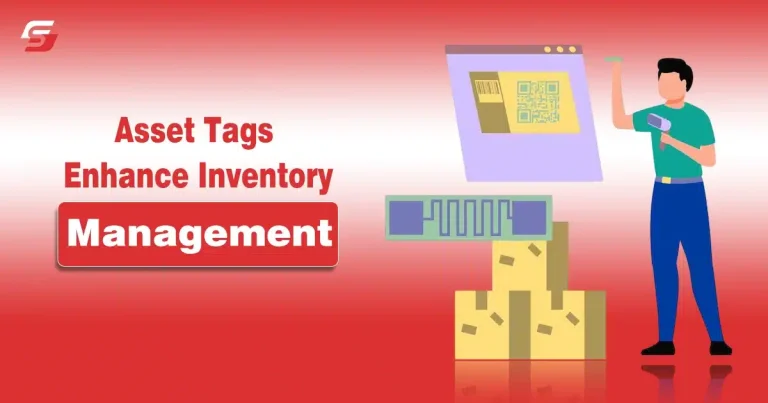For businesses, managing inventory effectively is an important factor in maintaining smooth operations.
One of the most innovative solutions gaining traction is the use of efficient asset tags. These small, often overlooked tools play an important role in streamlining inventory management that enhance accuracy, and save time.
Asset tags provide control over manual processes and reduce human error while improving asset tracking and accountability.
In this guide, learn about how adopting efficient asset tags can enhance your inventory management system and help you stay ahead of the curve.
What are Asset Tags? The Unsung Heroes of Inventory Management
Asset tags are small labels or stickers that businesses attach to their equipment, tools, or inventory. These tags primarily include a unique barcode, QR code, or serial number, which helps track and identify each item quickly and accurately.
Think of them like a digital ID for your assets. If the tags are integrated, you can easily check where the item is, who is using it, or when it was last serviced. They make managing your inventory much easier, reduce the risk of losing or misplacing items, and save a lot of time compared to manual tracking methods.
Asset Tagging From Barcodes to Smart Labels
Asset tagging has come a long way from its simple beginnings. It all started with barcodes those black-and-white lines we see on product packaging. Businesses used barcodes to track inventory by scanning them with a special reader. While barcodes were a big improvement over manual tracking, they had limitations, like requiring line-of-sight to scan and not holding much data.
As technology advanced, asset tagging evolved. Enter smart labels asset tags with more advanced features like QR codes and RFID (Radio Frequency Identification). These new tags can store more information, and some don’t even need to be directly scanned; they can be read from a distance. Smart labels make tracking assets even easier and faster, improving efficiency and reducing human error.
The shift from barcodes to smart labels marks a significant leap in asset management, making it easier to track and manage assets in real-time, no matter how large your inventory is.
Why Asset Tags Matter in Precision Inventory Management
Asset tags are important for precision inventory management because they allow businesses to track their assets with a level of accuracy that traditional methods just can’t match.
With each asset having a unique tag, you can easily identify and locate items in your inventory, reducing the chances of errors, misplacement, or theft.
The power of asset tags lies in their ability to automate and streamline the tracking process. Instead of relying on manual checks or handwritten logs, you can quickly scan a tag to get real-time data about the asset’s location, status, and usage. This results in fewer stock discrepancies, faster audits, and a better understanding of your inventory.
For businesses, that means less time spent searching for lost items, less overstocking or understocking, and more efficient operations overall. Asset tags help ensure that you’re not just managing inventory, but managing it with precision and ease.
How to Choose the Right Asset Tags?
As a businessman, don’t ever rely on low quality, as it results in poor customer experience. However, the same goes for asset tags like choosing the right one that is secure, accurate and efficient.
Here are some key factors to consider when selecting the best asset tags for your business:
- Material and Durability: You can choose asset tags made from durable materials, especially if your assets are exposed to harsh environments. For example, if your equipment is used outdoors, opt for weatherproof or waterproof tags that can resist wear and tear.
- Technology (Barcode, QR, RFID): Consider the technology that best fits your tracking needs. Barcodes are great for simple tracking, but RFID or QR codes offer more advanced capabilities, like scanning from a distance or storing more data on the tag.
- Size and Shape: The size of the asset tag should match the item you’re tagging. A tag that’s too big might be hard to attach to small items, while one that’s too small might not be readable. Choose one that’s easy to scan and fits well on your assets.
- Security Features: If security is a concern, look for asset tags that have tamper-evident features. These tags will show clear signs if someone tries to remove or alter them, giving you peace of mind about the safety of your assets.
- Customization: Some asset tags can be customized with your company logo, specific numbers, or other identifying details. Customization can make the tags more professional and help with better organization.
- Cost-Effectiveness: While you don’t want to skimp on quality, it’s important to find a balance between cost and functionality. Make sure you’re getting the best value for the features you need.
Asset Tags in the Digital Age
Now a days where technology is evolving, asset tags have also stood out from simple labels to powerful tools that help businesses stay ahead of the competition.
RFID vs. QR Codes: Decoding the Best Asset Tag Solution
With technological advancements, the options available for asset tagging have also changed, and RFID and QR codes are becoming the frontrunners of modern inventory management. RFID technology enables the automatic identification and tracking of people or objects using radio waves, which makes it especially well-suited for environments where efficiency is vital.
Because RFID can read multiple tags so it is less dependent on orientation, businesses can conduct bulk inventory checks without the manual effort of scanning 1-by-1.
In contrast, QR codes are an alternative that can be scanned using a line of sight and manual effort at the very least. But they are less costly and simpler to deploy, particularly for smaller companies that may lack the infrastructure required for RFID systems.
QR codes can link to vast datasets, menus, and websites, which opens a world of potential for context-rich asset management solutions.
Ultimately, the decision about whether to use RFID or QR codes will depend on the individual business’s operational needs, including budget and processing speed requirements. A data-driven decision can significantly improve both inventory efficiency and reduce waste.
Best Practices for Implementing Asset Tags: A Roadmap to Success
Implementing asset tags effectively can transform your inventory management, but doing it right requires careful planning and execution.
Here’s a roadmap to ensure your asset tagging system is set up for success:
1. Define Your Objectives
First of all, you can identify why you want to implement asset tags. Are you trying to improve inventory accuracy, prevent theft, or streamline audits? Knowing your goals will help you select the right asset tags and determine the best process for using them.
2. Select the Right Tags
It is another important factor to choose asset tags based on your specific needs. You can consider the environment (e.g., outdoor or harsh conditions), technology (barcode, QR, RFID), and durability. Make sure the tags can withstand the wear and tear your assets will face and are easy to scan.
3. Label All Assets
Begin tagging every asset you want to track. It might take time, but labeling all your equipment and inventory upfront is key for building a comprehensive system. Be consistent with where you place the tags—usually on visible, accessible spots on the items.
4. Implement a Scanning System
Set up a scanning system for quick and easy identification. This could include barcode scanners, mobile apps, or RFID readers, depending on the technology you’ve chosen. Make sure your team is trained to use the system efficiently.
5. Create a Centralized Database
Develop a database to store the information associated with each asset tag. This database should include details like the asset’s location, condition, and usage history. By keeping all this information in one place, you can quickly retrieve data and generate reports.
6. Train Your Team
Proper training is essential. Ensure that your team understands how to scan, update, and manage the tagged assets. Everyone should be familiar with the asset tracking system so it runs smoothly and errors are minimized.
7. Regular Audits and Updates
Conduct regular audits to ensure the asset tags are functioning properly and that the information in your database is up-to-date. As your inventory grows or changes, you may need to add new assets or reassign tags to existing ones.
8. Monitor Performance and Optimize
Track how well the asset tagging system is performing. Are you seeing fewer discrepancies in your inventory? Are assets easier to locate? Use feedback from your team to improve and refine the process as needed.
Combining Asset Tags with Inventory Management Systems
Well, combining asset tags with inventory management systems creates a powerful solution for tracking and managing assets.
Asset tags, like barcodes or RFID labels, make it easy to identify and track each item in your inventory. When paired with an inventory management system, the data from these tags is automatically updated in real time.
This helps businesses know exactly where each asset is, who is using it, and when it’s due for maintenance. Companies can reduce errors, save time, and improve accuracy, which makes it easier to manage large inventories and ensure assets are always accounted for.





